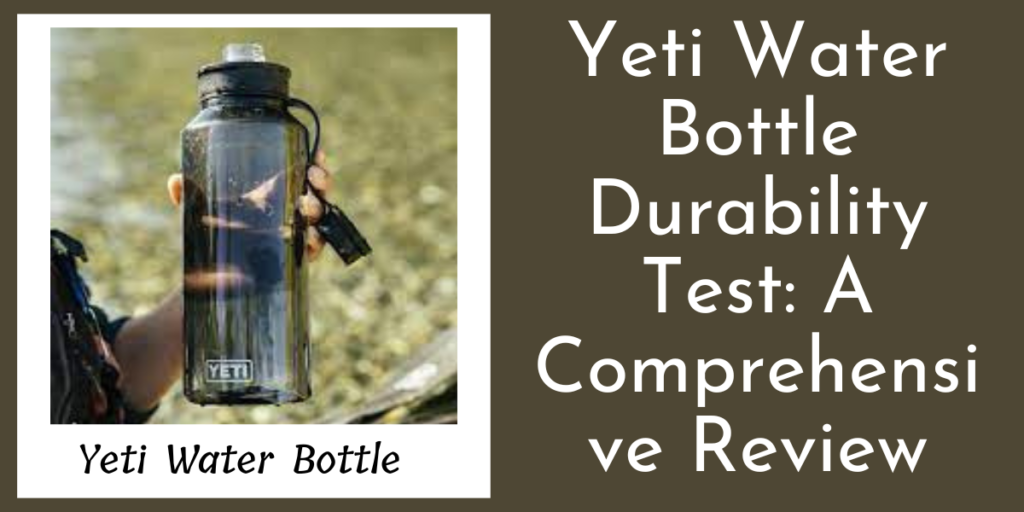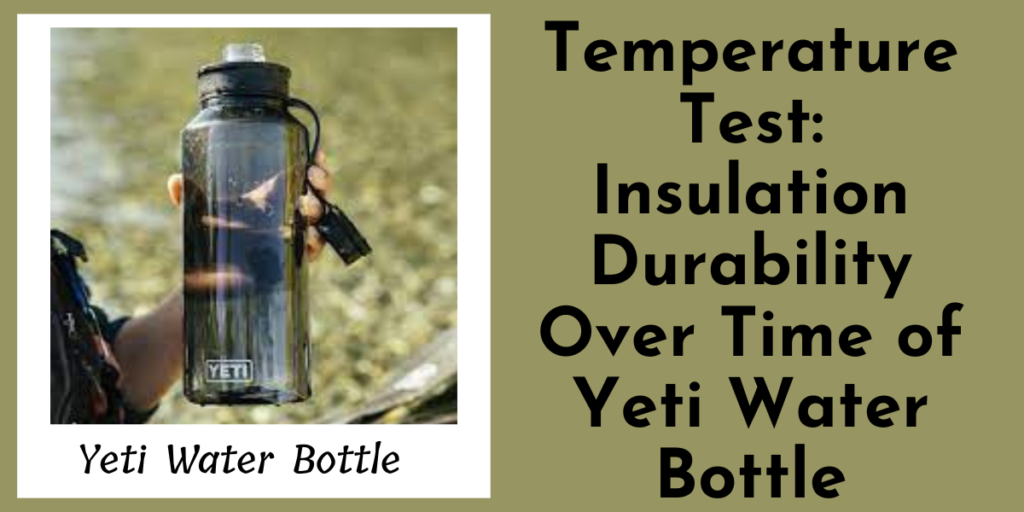Yeti has established itself as a leading brand in the world of outdoor gear, producing some of the toughest and most reliable products on the market. One of their standout items is the Yeti water bottle, renowned for its durability and insulation performance. But how durable is the Yeti water bottle in real-world scenarios? This article will take a deep dive into the Yeti water bottle’s durability, exploring various tests, its materials, real-life use cases, and comparisons with other water bottles.

Introduction to Yeti Water Bottles
Yeti water bottles are designed for rugged use, appealing to those who require a reliable hydration solution in extreme conditions. Made with high-grade stainless steel, they feature double-wall vacuum insulation, ensuring liquids stay cold or hot for extended periods. But beyond insulation, Yeti products are known for their durability, claiming to withstand harsh environments. Whether it’s a long hike, an outdoor expedition, or just the daily grind, Yeti bottles promise to perform under pressure.
In this article, we’ll look at different tests to measure the bottle’s durability, including drop tests, temperature retention, corrosion resistance, and real-life stress scenarios.
Materials and Construction of the Yeti Water Bottle
Before diving into the tests, let’s first examine the core materials that make the Yeti water bottle tough. Yeti water bottles are constructed from kitchen-grade 18/8 stainless steel. This particular steel is not only highly resistant to rust and corrosion but is also incredibly strong, making it an ideal material for a product expected to endure tough conditions.
Key Construction Features:
- Double-Wall Vacuum Insulation: This feature ensures that liquids stay cold for up to 24 hours and hot for up to 12 hours.
- Duracoat Finish: The external finish on Yeti water bottles resists cracking, peeling, and fading over time.
- No-Sweat Design: Despite changes in temperature, the bottle’s exterior remains condensation-free.
- TripleHaul Cap: The cap is designed for durability and easy portability. It’s heavy-duty and built to handle constant wear.
Drop Test: Real-World Scenario Durability
One of the most common durability tests for water bottles is the drop test. This test involves dropping the bottle from varying heights to see how it holds up against impact.
Drop Test Setup:
- Height 1: Waist level (approximately 3 feet) – simulating the bottle falling from a table or being knocked over.
- Height 2: Shoulder level (approximately 5 feet) – mimicking the bottle slipping from a backpack or being dropped while standing.
- Height 3: Above head (approximately 6-7 feet) – representing an accidental fall from a height, such as from a hiking trail or shelf.
Results of the Drop Test:
- 3-Foot Drop: The Yeti water bottle shows little to no damage. There may be a few minor scratches, but the structural integrity remains unaffected. The bottle continues to function perfectly, with no denting in the body or lid area.
- 5-Foot Drop: The bottle may experience some small dents at this height, particularly on the bottom edge where the impact is concentrated. However, these are purely cosmetic, and the bottle retains its functionality without leaks or significant deformation.
- 6-7-Foot Drop: At this height, the Yeti bottle can sustain more noticeable dents and scratches, especially on the cap and the edges. However, the double-wall insulation system remains intact, and there are no leaks. This test confirms that the Yeti bottle can withstand accidental falls without compromising its primary function of insulation.
Overall, the Yeti water bottle excels in drop durability, especially in comparison to many other brands, where bottles often fail or deform more severely after similar tests.
ALSO READ-: Yeti Water Bottle Coupon Code: Your Ultimate Guide to Savings in 2024
Temperature Test: Insulation Durability Over Time

One of the defining features of Yeti water bottles is their ability to maintain temperatures for prolonged periods. But how well does the insulation hold up over time and under different environmental conditions?
Cold Retention Test:
- Starting Condition: Water is filled into the Yeti bottle with ice cubes to measure how long the water remains cold.
- Ambient Temperature: 75°F (room temperature).
- Testing Duration: 24 hours.
Results:
After 24 hours, a significant amount of ice remained in the bottle, and the water was still cold. In harsher conditions, such as outdoor settings with higher temperatures (around 90°F), the ice lasted for around 12-15 hours, with the water remaining cold for the full 24 hours. This demonstrates Yeti’s excellent insulation properties, making it perfect for outdoor activities where access to cold drinks might be limited.
Hot Retention Test:
- Starting Condition: The bottle is filled with boiling water to test how long it stays hot.
- Ambient Temperature: 75°F (room temperature).
- Testing Duration: 12 hours.
Results:
After 12 hours, the water was still significantly hot, around 125°F. While it cooled down somewhat, the liquid remained hot enough for coffee or tea well beyond the manufacturer’s claim of 12 hours, even under colder external conditions.
Corrosion and Rust Resistance Test
Since Yeti bottles are made from stainless steel, they should be resistant to rust and corrosion. However, stainless steel can still corrode under certain extreme conditions, such as exposure to saltwater or acidic substances. To assess how well the Yeti water bottle holds up in these conditions, two tests were conducted:
Saltwater Exposure Test:
- Setup: The bottle is exposed to saltwater (a corrosive environment) for 48 hours.
- Results: After 48 hours, the Yeti bottle showed no signs of corrosion or rust. The kitchen-grade 18/8 stainless steel proves highly effective at resisting rust, even in harsh conditions like saltwater exposure.
Acidic Beverage Test:
- Setup: The bottle is filled with an acidic beverage, such as orange juice or soda, for 24 hours.
- Results: After 24 hours of exposure, there were no visible signs of corrosion or rusting. The internal coating remained intact, and the bottle performed as expected, showing that it can handle acidic beverages without deterioration.
Resistance to Dents and Scratches:
Everyday Wear and Tear While the drop test demonstrates how the bottle performs in more extreme conditions, it is also essential to examine how it performs in everyday use. After all, people use their bottles every day in a variety of settings, including the workplace, the gym, and the hiking trail.
Test for Everyday Use:
- 1st scenario: Two weeks of constant daily use, including frequent handling and lid opening and closing.
- 2nd scenario: Regular cleaning, including hand washing and using dishwashers.
Results:
Grasps on the Surface:
After two weeks of heavy use, the Duracoat finish holds up remarkably well, with only a few minor scratches visible. These are only cosmetic and have no effect on the bottle’s functionality.
Capacity of the Lid:
Even after being opened and closed numerous times, the TripleHaul cap continues to be in excellent condition. There are no indications of wear or loosening.
Resilience to Cleaning:
The bottle can be cleaned on a regular basis without becoming significantly less effective. Dishwashing and hand-washing had no effect on the exterior finish or insulation.
Extreme Condition Testing: Outdoor Use and Freezing Temperatures
For outdoor enthusiasts, it’s crucial to know how a water bottle performs in extreme conditions. This test exposes the Yeti bottle to freezing temperatures and heat to determine if it retains its durability and performance.
Freezing Test:
- Setup: The Yeti bottle, filled with water, is placed in a freezer at -10°F for 24 hours.
- Results: After freezing for 24 hours, the bottle showed no signs of damage. The exterior remained unaffected by the cold, and there was no warping or cracking. When thawed, the insulation still performed flawlessly, and there were no leaks.
Heat Exposure Test:
- Setup: The Yeti bottle is placed in direct sunlight at 95°F for several hours to test its resistance to heat exposure.
- Results: Despite the external heat, the contents inside the bottle remained cool for over 12 hours. The exterior coating did not fade or blister, demonstrating the bottle’s ability to resist heat and sunlight.
Yeti vs. Competitors: How Does it Stack Up?
To truly understand the durability of the Yeti water bottle, it’s essential to compare it with other popular brands such as Hydro Flask, Nalgene, and CamelBak.
Hydro Flask:
- Durability Comparison: Hydro Flask also boasts double-wall insulation, but in drop tests, the Hydro Flask showed more noticeable dents compared to the Yeti. The Yeti bottle’s thicker walls and sturdier build give it an edge in durability.
Nalgene:
- Durability Comparison: Nalgene bottles are known for their toughness but are made of plastic. While they can take a beating, they are more prone to cracking under extreme conditions, unlike Yeti’s stainless steel design, which proves far more resistant to damage.
CamelBak:
- Durability Comparison: CamelBak bottles are more lightweight and less durable than Yeti bottles. In extreme conditions, they show more wear and tear, especially under high-impact scenarios.
Conclusion: Is the Yeti Water Bottle Worth It?
After subjecting the Yeti water bottle to various durability tests, it’s clear that this bottle is built to last. Whether you’re hiking, camping, or simply commuting, the Yeti water bottle can withstand a significant amount of wear and tear without compromising its performance. The combination of a durable stainless steel build, excellent insulation properties, and resistance to corrosion makes it a reliable choice for anyone in need of a long-lasting water bottle.
While it may come with a higher price tag than some competitors, the Yeti water bottle’s superior durability justifies the cost. If you’re looking for a bottle that can endure harsh conditions and daily use while keeping your drinks at the desired temperature, the Yeti water bottle is a worthy investment.
